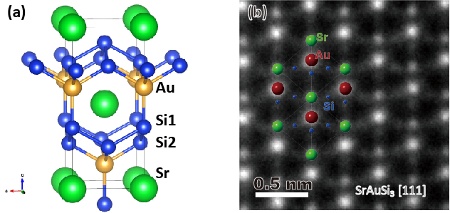Novel Gold-based Superconductor SrAuSi3 Discovered
Development of superconducting materials that have broken spatial inversion symmetry
2014.03.25
(2014.04.18 Update)
National Institute for Materials Science
The National Institute for Materials Science (NIMS) research team of Masaaki Isobe and Hiroyuki Yoshida, the leader and a postdoctoral fellow, respectively, belonging to the Superconducting Properties Unit and Strongly Correlated Materials Group, Koji Kimoto, the director of the Surface Physics and Structure Unit, Masao Arai, the principal researcher of the Computational Materials Science Unit and Material Properties Theory Group, and Eiji Muromachi, executive vice president, synthesized a novel superconductor, SrAuSi3, which contains gold as a principal constituent element.
Abstract
- The NIMS (Sukekatsu Ushioda, executive president) research team consisting of Masaaki Isobe and Hiroyuki Yoshida, the leader and a postdoctoral fellow, respectively, belonging to the Superconducting Properties Unit and Strongly Correlated Materials Group, Koji Kimoto, the director of the Surface Physics and Structure Unit, and Masao Arai, the principal researcher of the Computational Materials Science Unit and Material Properties Theory Group, and Eiji Muromachi, executive vice president, synthesized a novel superconductor, SrAuSi3, which contains gold as a principal constituent element.
- Based on the BCS theory, which successfully explained the superconductivity phenomenon for the first time in terms of the electron theory, it had been the prevalent belief that the formation of a Cooper pair (a pair of conduction electrons) was possible only in high-symmetry space groups. However, it was discovered in recent years that superconductivity also occurs in low-symmetry space groups (substances whose crystal structure lacks spatial inversion symmetry). That mysterious electronic state and the mechanism that causes the phenomenon have attracted the interest of many condensed-matter physicists. This type of superconductivity, in which the substance involved has a crystal structure that lacks spatial inversion symmetry and is spatially asymmetric, is called “superconductivity with broken spatial inversion symmetry”. Theoretically, the parity of such superconductors is not fixed to either an even or odd function in terms of the wave function of the Cooper pair, indicating that they possess an unconventional electronic state called “parity-mixing superconductivity.” A number of attempts are being made to verify this theoretical prediction. At the same time, it is also vital to discover such novel substances in order to expand research opportunities.
- The research team recently searched for novel substances that lack spatial inversion symmetry in their crystal structures. As a result, they successfully synthesized a new compound, SrAuSi3, and found that it exhibits superconductivity at the absolute temperature of 1.6 K (-271.55°C). This compound belongs to a group having a so-called BaNiSn3-type structure (general chemical formula: AMX3, where M represents a transition-metal element). The transition metal M is the most important element in this type of superconductors in determining their electronic structure. For superconductivity with broken spatial inversion symmetry to work, strong spin-orbit interactions are the key, which are closely correlated to the atomic weight of the element M. The research thus far on superconductivity with broken spatial inversion symmetry has mostly focused on compounds that contain a relatively heavy element M, such as rhodium (Rh), iridium (Ir), and platinum (Pt). However, using a high-pressure synthesis method, the research team recently succeeded for the first time in the synthesis of a compound having the same general chemical formula but using gold (Au), which is even heavier, as element M. After carrying out theoretical calculation analysis, they found that the electronic structure of the new substance, SrAuSi3, was greatly different from those of conventionally studied compounds. It is speculated that the use of Au contributed to a greater number of electrons, as indicated by its large atomic number, and to stronger spin-orbit interactions. Furthermore, it was also discovered that some of the conduction electrons are influenced by the spin-orbit interactions. If those influenced electrons are responsible for the induction of superconductivity, they may be causing the unconventional superconducting state. Further experiments are necessary to verify these findings.
- One of the predicted properties associated with superconductivity with broken spatial inversion symmetry is the extremely high upper critical field (the maximum magnetic field value at which superconductivity is sustained). This state is caused by the fact that the spin of the Cooper pair is so tightly fixed to a certain direction by the spin-orbit interactions that the relative influence of the external magnetic field on the spin direction of the Cooper pair becomes small. In order to take full advantage of this novel property, it is vital to understand this electronic state in detail. The discovery of this substance is expected to contribute not only to the understanding of the mechanism involved in superconductivity with broken spatial inversion symmetry but also to the development of new superconducting materials that are usable in a magnetic field.
- The results of this research has been published in the Issue 6 of Vol. 26 (March 25, 2014) of Chemistry of Materials, a journal distributed by the American Chemical Society.

Figure 1 from the press release material. Crystal structure (a) and STEM (Scanning Transmission Electron Microscope) lattice image (b) of SrAuSi3.
